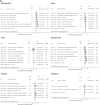Do healthier foods and diet patterns cost more than less healthy options? A systematic review and meta-analysis
- PMID: 24309174
- PMCID: PMC3855594
- DOI: 10.1136/bmjopen-2013-004277
Do healthier foods and diet patterns cost more than less healthy options? A systematic review and meta-analysis
Abstract
Objective: To conduct a systematic review and meta-analysis of prices of healthier versus less healthy foods/diet patterns while accounting for key sources of heterogeneity.
Data sources: MEDLINE (2000-2011), supplemented with expert consultations and hand reviews of reference lists and related citations.
Design: Studies reviewed independently and in duplicate were included if reporting mean retail price of foods or diet patterns stratified by healthfulness. We extracted, in duplicate, mean prices and their uncertainties of healthier and less healthy foods/diet patterns and rated the intensity of health differences for each comparison (range 1-10). Prices were adjusted for inflation and the World Bank purchasing power parity, and standardised to the international dollar (defined as US$1) in 2011. Using random effects models, we quantified price differences of healthier versus less healthy options for specific food types, diet patterns and units of price (serving, day and calorie). Statistical heterogeneity was quantified using I(2) statistics.
Results: 27 studies from 10 countries met the inclusion criteria. Among food groups, meats/protein had largest price differences: healthier options cost $0.29/serving (95% CI $0.19 to $0.40) and $0.47/200 kcal ($0.42 to $0.53) more than less healthy options. Price differences per serving for healthier versus less healthy foods were smaller among grains ($0.03), dairy (-$0.004), snacks/sweets ($0.12) and fats/oils ($0.02; p<0.05 each) and not significant for soda/juice ($0.11, p=0.64). Comparing extremes (top vs bottom quantile) of food-based diet patterns, healthier diets cost $1.48/day ($1.01 to $1.95) and $1.54/2000 kcal ($1.15 to $1.94) more. Comparing nutrient-based patterns, price per day was not significantly different (top vs bottom quantile: $0.04; p=0.916), whereas price per 2000 kcal was $1.56 ($0.61 to $2.51) more. Adjustment for intensity of differences in healthfulness yielded similar results.
Conclusions: This meta-analysis provides the best evidence until today of price differences of healthier vs less healthy foods/diet patterns, highlighting the challenges and opportunities for reducing financial barriers to healthy eating.
Keywords: HEALTH ECONOMICS; PREVENTIVE MEDICINE; PUBLIC HEALTH; SOCIAL MEDICINE.
Figures







References
-
- Banks J, Marmot M, Oldfield Z, et al. Disease and disadvantage in the United States and in England. JAMA 2006;295:2037–45 - PubMed
-
- Kant AK, Graubard BI. Secular trends in the association of socio-economic position with self-reported dietary attributes and biomarkers in the US population: National Health and Nutrition Examination Survey (NHANES) 1971–1975 to NHANES 1999-2002. Public Health Nutr 2007;10:158–67 - PubMed
-
- Mackenbach JP, Stirbu I, Roskam AJ, et al. Socioeconomic inequalities in health in 22 European countries. N Engl J Med 2008;358:2468–81 - PubMed
-
- Darmon N, Drewnowski A. Does social class predict diet quality? Am J Clin Nutr 2008;87:1107–17 - PubMed
-
- Bittman M. Is junk food really cheaper? The New York Times 24 September 2011
Grants and funding
LinkOut - more resources
Full Text Sources
Other Literature Sources
Miscellaneous
